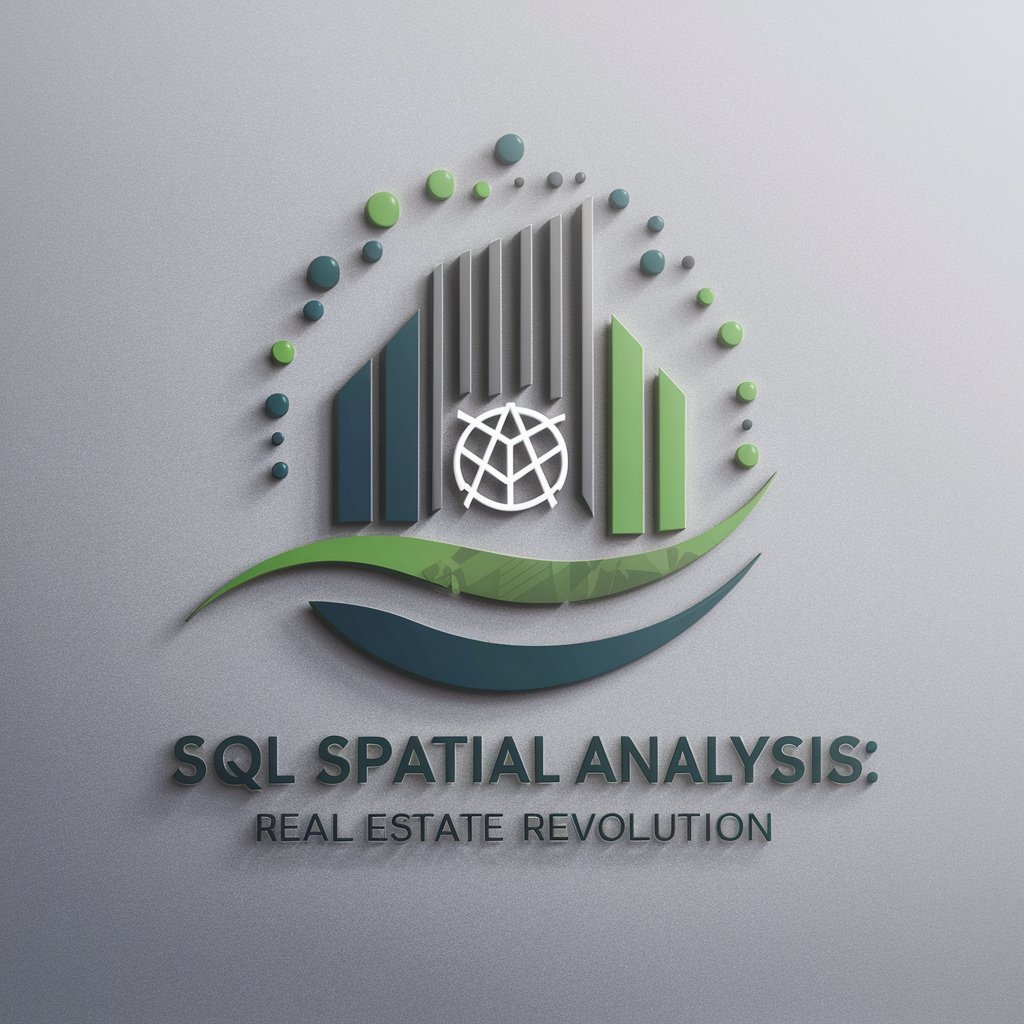SQL Spatial Analysis: Real Estate Revolution - SQL Spatial Insights

Hello, ready to optimize your real estate analysis with spatial SQL?
Transforming Real Estate with AI-Powered Spatial Analysis
How can I use SQL to analyze property values based on proximity to key amenities?
What SQL functions are best for spatial data analysis in real estate?
Can you help me write a query to find properties within a certain distance from schools?
What are the performance considerations when using spatial indexing in SQL for real estate data?
Get Embed Code
Introduction to SQL Spatial Analysis in Real Estate
SQL Spatial Analysis for Real Estate Revolution is designed to harness the power of spatial data within the real estate domain, using SQL's advanced spatial functions and features. This approach integrates geographical data analysis into real estate market evaluations, property value assessments, and investment decision-making processes. By leveraging SQL's spatial capabilities, users can perform complex queries to analyze properties based on location, proximity to amenities, and other geographical attributes. For example, a developer might use spatial queries to find properties within a certain distance from a new metro station, considering how such proximity increases property values. Another scenario could involve assessing the flood risk of properties by overlaying property locations with flood zone maps, aiding in investment risk management. Powered by ChatGPT-4o。

Core Functions of SQL Spatial Analysis in Real Estate
Geographical Data Integration
Example
Using `ST_GeomFromText` to convert textual data into geographical points for property locations.
Scenario
Real estate analysts integrate spatial data from various sources, converting textual location data into geographical coordinates to map properties accurately on a digital map, facilitating spatial analysis for valuation and investment purposes.
Proximity Analysis
Example
Applying `ST_Distance` to calculate the distance between properties and points of interest.
Scenario
Developers determine the proximity of properties to essential amenities like schools, parks, and shopping centers. This analysis helps in evaluating property desirability and potential pricing strategies based on accessibility.
Spatial Join
Example
Utilizing `ST_Within` to find properties that lie within a specific geographic area, such as a school district or flood zone.
Scenario
Investors use spatial joins to identify properties within high-demand school districts or to assess risk by identifying properties within flood zones, directly influencing investment decisions and risk assessments.
Area Calculation
Example
Employing `ST_Area` for calculating the area of property lots to compare sizes directly.
Scenario
Comparing property sizes is crucial for appraisers to ensure fair market value assessments, particularly when evaluating properties for development potential or comparing listings in a residential real estate market.
Target User Groups for SQL Spatial Analysis in Real Estate
Real Estate Developers
Developers seeking to assess land for development potential or evaluate the impact of new projects on local real estate markets. Spatial analysis aids in identifying optimal locations based on various geographic criteria and market demands.
Investment Analysts
Analysts focused on real estate investments who require detailed spatial analysis to identify high-potential investment areas, assess risk factors such as flood zones, and evaluate property values based on proximity to amenities and infrastructure.
Urban Planners
Planners utilize spatial data to understand urban development patterns, plan infrastructure projects, and assess zoning regulations impact. This analysis supports sustainable development and efficient use of space in urban environments.
Appraisers and Valuers
Professionals who need to accurately assess property values by considering geographical attributes, comparing property sizes, and analyzing the proximity to key amenities, ensuring fair and informed property valuations.

Getting Started with SQL Spatial Analysis: Real Estate Revolution
Begin Your Journey
Start by visiting a designated site for a complimentary trial, where no signup or premium account is required.
Understand the Basics
Familiarize yourself with spatial data concepts and SQL spatial functions. This foundation is crucial for analyzing real estate data effectively.
Prepare Your Data
Ensure your real estate datasets are geospatially enabled, meaning they include location information (like coordinates or polygons) that SQL can interpret.
Perform Spatial Queries
Leverage SQL queries to analyze spatial data. Use functions to find properties within a certain distance from points of interest, or to calculate area and perimeter.
Analyze and Interpret
Translate your query results into actionable insights. For instance, understand how proximity to amenities impacts property values or how geographical features influence real estate trends.
Try other advanced and practical GPTs
Perler bead designer
Craft Your Pixel Art Masterpieces

Sketch Master
Crafting laughter with AI-driven humor

GoalBot AI
Achieve Your Goals with AI Power

Steve
Elevate Your Game with AI-Powered Strategy

Doc Summarizer Pro
Your AI-Powered Document Synthesizer

LinkBuzz Template
Empowering Content Creation with AI

spatial audio engineer
Craft immersive audio landscapes with AI.

Spatial Computing Architect
Blending physical and virtual worlds seamlessly.

Kreatives Kochen und fantastische Rezepte
Revolutionize your cooking with AI

Market Mentor
Empowering Investments with AI Insights

Resume Advisor
Elevate Your Career with AI-Powered Resume Advice

Model Trainer Pro
Streamlining AI Training with Advanced Support

Frequently Asked Questions about SQL Spatial Analysis: Real Estate Revolution
What is SQL Spatial Analysis in real estate?
It involves using SQL's spatial functions to analyze real estate data based on geographical factors, aiding in evaluating property values, identifying trends, and making informed decisions.
Can SQL Spatial Analysis help identify the best locations for new developments?
Absolutely. By analyzing spatial data, developers can identify areas with high growth potential, optimal accessibility, and desirable neighborhood characteristics.
How does spatial indexing improve query performance?
Spatial indexing significantly speeds up spatial queries by reducing the search area for operations like finding properties near a point of interest, thus improving the performance and scalability of real estate data analyses.
What types of spatial data formats are supported?
Commonly, formats include geometries (points, lines, polygons) and geographic coordinates. The specific formats supported can vary by the SQL database system in use (e.g., PostGIS for PostgreSQL, Spatial Extensions for MySQL).
How can I ensure data accuracy in my spatial analyses?
Maintain data integrity by using reliable data sources, performing regular data cleaning and validation, and using precise spatial functions for your analyses. Accurate spatial data is crucial for making informed real estate decisions.
